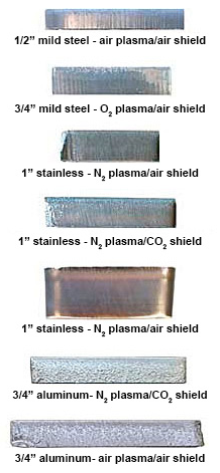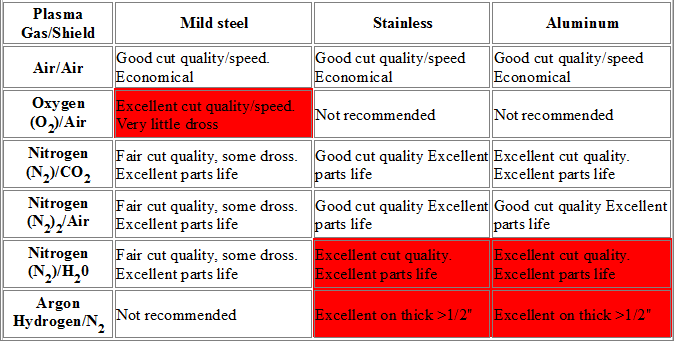Plasma Gas Selection Information
Contents
CUSTOMER “GAS” SELECTION INFORMATION
For Plasma Torch Consumption
Many fabricators choose plasma systems with "dual-gas" or "multi-gas" capability. This means that a variety of plasma and shield gases can be used for various applications. Multi-gas torches offer the most flexibility for shops that cut a variety of materials. Different gases are used, depending on material type and thickness, in order to achieve the best balance of cut quality, parts life, productivity, and overall cost of operation. Most plasma system manuals tend to overwhelm the operator with a confusing array of cut charts and gas choices. Often when you ask the operator why a particular gas is used for a cutting task a typical answer is: "My gas supplier told me to use this gas." The intent of this article is to provide a brief overview of the advantages and disadvantages of each gas and make "best case" recommendations for cutting the three most common materials: mild steel, stainless steel and aluminum.
Air
Air is the most versatile plasma gas; it produces good cut quality and speed on mild steel, stainless, and aluminum. Air also lowers the cost of operation because it is not necessary to purchase gases. (For this reason air plasma systems are not popular with gas suppliers). However air is not free. Shop air must be cleaned to remove contamination such as particulate, oil mist, and moisture. The best solution for air plasma systems is a good-sized, dedicated air compressor, a refrigerated dryer, and a bank of filters to take out particulate, oil mist, and any remaining moisture. Another concern with air plasma is weldability of the cut edge. Some nitriding and oxidation of the cut surface occurs with air plasma; this can cause porosity in welds. The problem is usually corrected by simply using good quality weld wire with denitriders and deoxidizers. For versatility, good speed, low dross levels, and parts life up to 600 starts, air is a good option for many shops. Air shield gas is the best choice when using air plasma.
Oxygen
Oxygen has become the industry standard for cutting mild steel because it provides the best cut quality and fastest cutting speed of any plasma gas. (Cutting stainless or aluminum with oxygen plasma gas is not recommended). Oxygen plasma gas reacts with carbon steel to produce a finer spray of molten metal, each droplet having a lower surface tension. This molten spray is more easily ejected from the kerf. The disadvantage of oxygen is the cost of the gas and the consumable parts life. However state-of-the-art oxygen plasma systems use inert starting gases (such as nitrogen) with oxygen plasma to achieve similar parts life to nitrogen or air systems. These systems may have parts life in the 800-1500-start range. Increased consumable and gas costs are usually offset by a decrease in expensive secondary operations to remove dross and straighten beveled parts. Air shield is typically used with oxygen plasma.
Nitrogen
Nitrogen was used in most early plasma torches. It is still the best choice if you cut a lot of aluminum and stainless. The cut quality and parts life is excellent. (Over 1000 starts is normal) However, on thick materials (usually over ½"), at the high end of your plasma system's capability, switch to argon-hydrogen. Generally air is the best secondary when using nitrogen plasma. CO2 works well-slightly improving surface finish, cutting speed, and parts life over air. But CO2 costs more than air and requires multiple manifolded gas cylinders or a bulk system to deliver adequate flow. Water is a good secondary to use with nitrogen plasma if the system allows. It makes a very smooth shiny cut surface on stainless and aluminum. Water secondary must be used with a water table. Argon hydrogen Argon hydrogen is the gas of choice for thick stainless and aluminum cutting (> 1/2") The mixture typically used is 35% hydrogen: 65% argon (H-35). Argon hydrogen is the hottest burning plasma gas and provides the maximum cutting capability. (Argon hydrogen is used in water injection torches up to 1000 amps for cutting up to 6" stainless). In multi-gas torches, Argon hydrogen provides a straight cut and a very smooth almost polished surface on stainless steel. Some jagged dross may occur along the bottom edge. Nitrogen is typically used as the shield gas with argon hydrogen. The disadvantage of this combination is its expense.
Illustrated guide to plasma gas selection:
Conclusion:
The best gas to use depends, mainly on three considerations: cut quality, productivity, and economy. For mild steel use oxygen plasma and air shield for the best cut quality, lowest dross levels, minimal rework, excellent weldability and highest cutting speed/productivity. For best cut quality on stainless and aluminum under 1/2" use nitrogen plasma and air secondary for a good balance of cut quality and affordability. For a slightly better and faster cut, use CO2 as the secondary. If your system allows, water shield will provide the best edge quality. For best cut quality on thick stainless and aluminum use argon-hydrogen with nitrogen secondary. WARNING: your system must be equipped for safe operation with argon hydrogen gas. For most economical cutting, clean dry shop air is the best choice for mild steel, stainless, and aluminum.

